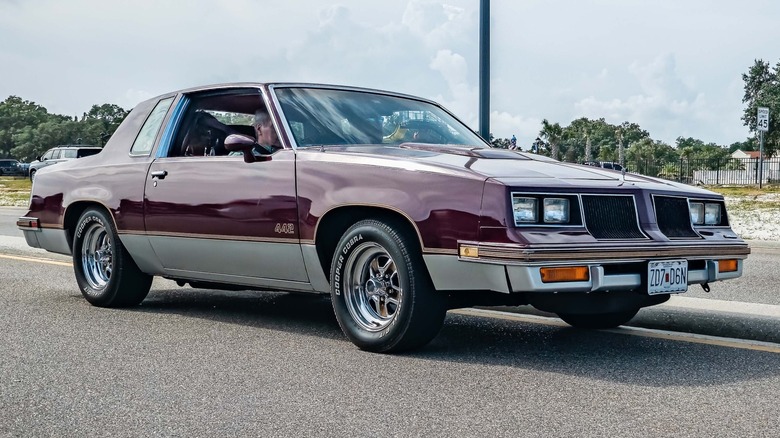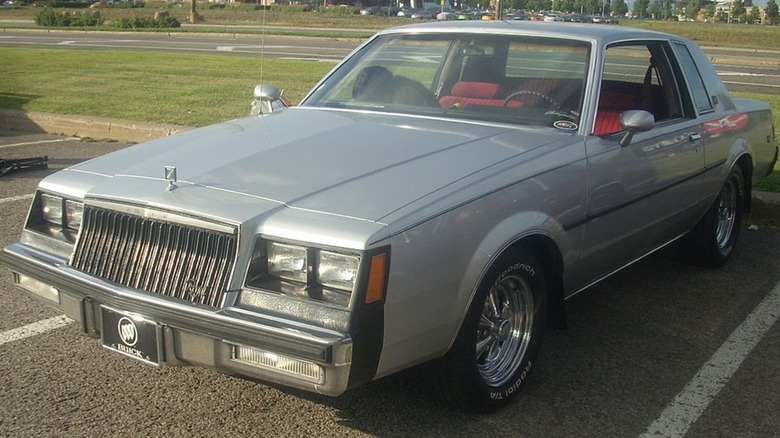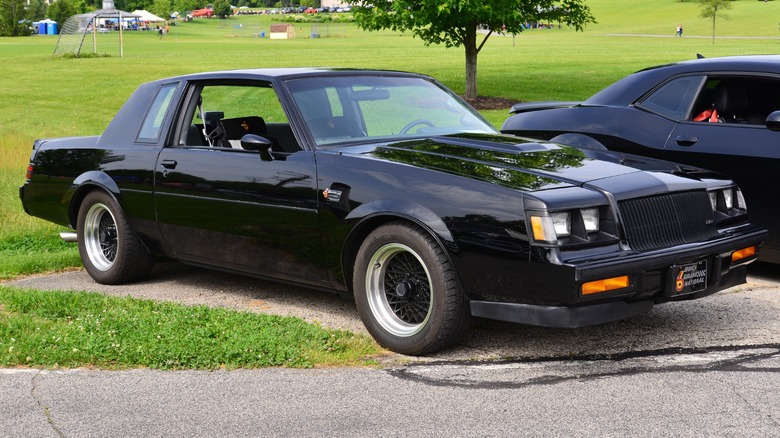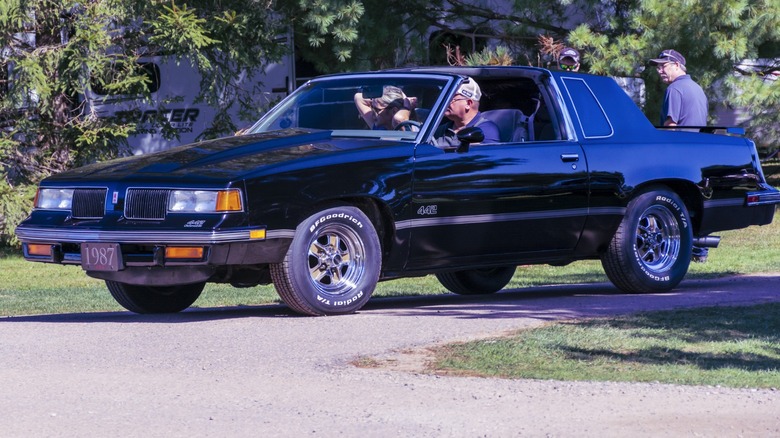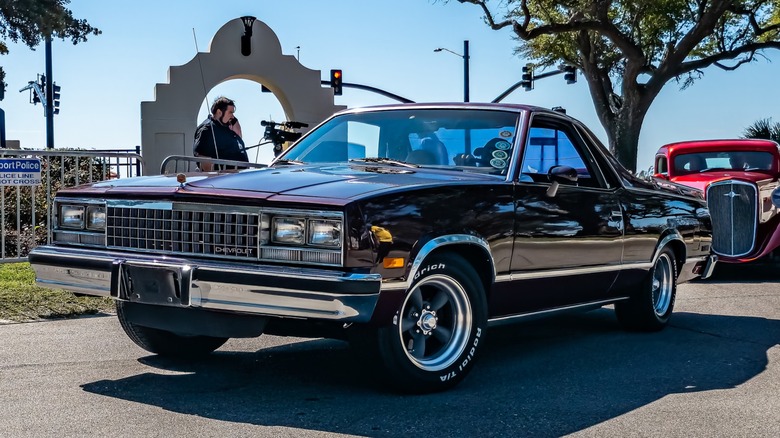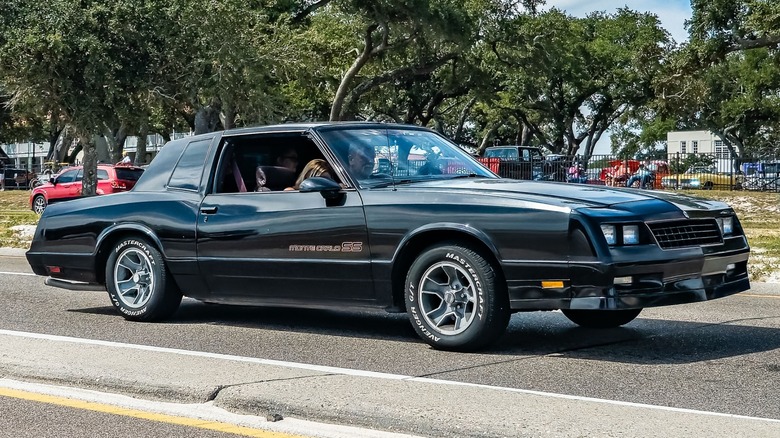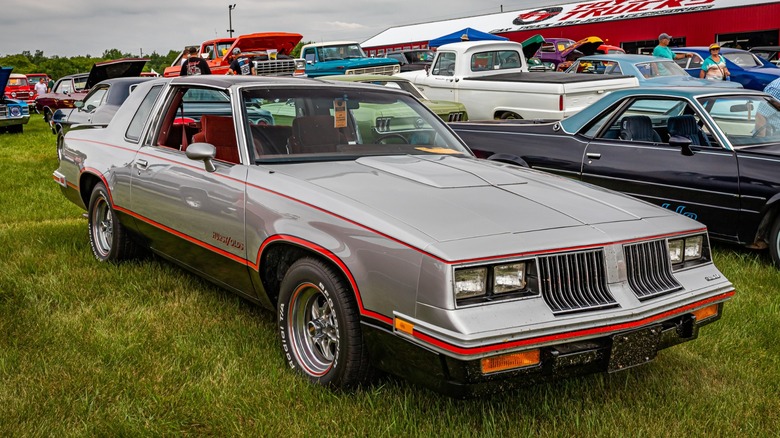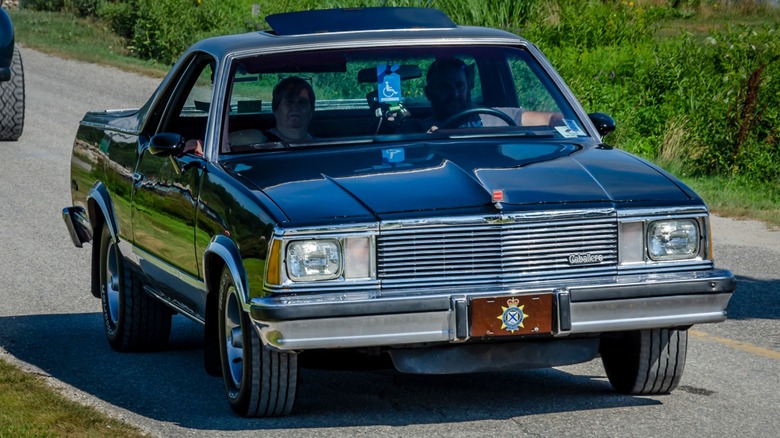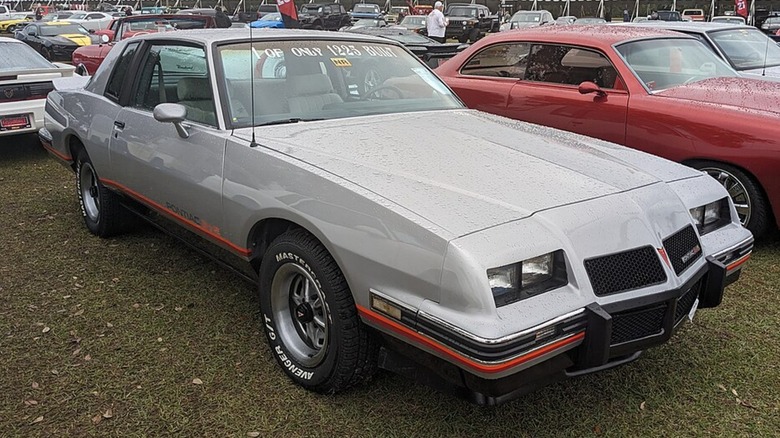8 Of GM's Most Iconic G-Body Muscle Cars
In the 1970s, an auto industry beset by multiple storms reacted to changes in consumer demand due to oil shortages, price spikes, and long lines at the pumps. As car buyers relinquished their thirsty barge-like domestic cars for more fuel-efficient options, often finding themselves looking over newly imported options from Japan, domestic automakers worked quickly to reduce the size of their models to meet the demand for more efficient cars.
A highly successful platform of corporate giant General Motors, the G-body began as the A-body in 1978, during widespread downsizing of models across the domestic car industry. The new G-body, which mostly carried over every model built on the A-platform, provided GM's multiple divisions with a versatile platform to make coupes, sedans, and wagons large enough to provide comfort for a whole family, without requiring a Navy Aircraft Handler to park at the grocery store.
Built in the millions on the G-body platform were the Chevrolet Monte Carlo and Malibu, Pontiac Bonneville and Grand Prix, Buick Regal, and Oldsmobile Cutlass cars as well as two trucks, the Chevrolet El Camino and GMC Caballero. These vehicles were ubiquitous on American highways for a couple of decades, and it seemed at the time like everyone's family had at least one in the driveway, particularly the Cutlass. However, a few G-bodies demonstrated GM's ability to build something special out of its mass market platform, thus elevating the following models up to icon status.
1. Buick Regal Sport Coupe
Buick adopted the V6 engine layout earlier than other domestic manufacturers, gaining valuable engineering expertise years before the V6 became commonplace. The original design debuted in 1961, but would not see a concerted effort for widespread adoption until 1974, as the energy crisis forced economy on automakers. However, the 3.8-liter engine launched that year became widely used and appreciated for its robust design.
When Buick put together its plans for a new model riding on the G-body platform, the V6 featured prominently among engine options. With power output severely limited at the time, Buick wanted an option that offered a good mix of power and economy, achieving this with a turbocharger.
For 1978, buyers could get the new Regal Sport Coupe with a turbocharged 3.8-liter V6, raising horsepower from 105 to either 150 or 165, depending on the carburetor chosen. The A-body version continued to be offered after the G-body designation change. To prevent engine-killing detonation without using water injection as the turbocharged 1962 Oldsmobile Jetfire had done, Regals received Buick Electronic Spark Control, an industry first. While the turbo V6 performed well, it provided few tangible advantages over a V8, even adding a couple of drawbacks, such as reliability. Therefore, the Regal Sport Coupe never caught on or sold in large quantities, though it laid the foundation for Buick to improve upon its turbocharging efforts, which paid dividends in the years following.
2. Buick Grand National
As racing has long been used to market various models of car, automakers often adopt certain terms from successful races to use on production cars. With back-to-back championships earned by Darrell Waltrip in a Regal, in 1982 Buick decided to offer an option package to its Regal Sport Coupe called Grand National. This included an appearance package and suspension upgrades, but most came without a turbo.
Skipping 1983, the Grand National returned in 1984, but this time as a standalone model packed with performance options, including a tuned turbo 3.8-liter V6 producing 200 horsepower, a competitive output at the time. With all black paint and a complete lack of chrome trim, the sinister coupe became an instant hit.
Subsequent years saw increases in power from better tuning and components, including the addition of an intercooler in 1986. For the final year of production, Buick released the GNX, a limited-production model with 276 horsepower and the ability to beat a Ferrari in a ¼-mile race. Just 547 examples of the GNX were built, making it one of the most collectible Buicks ever. The entire run of Grand Nationals remain highly valuable and desirable as they reached the status of icon the minute they were announced. Buick has long been associated with older drivers who generally avoid spirited driving, but once in a while it delivered cars like this to remind us that Buick can deliver thrills when it wants to.
3. Oldsmobile 442
The Pontiac GTO debuted in 1964, often credited for starting the muscle car trend. Unwilling to be bested by its sister division within GM, Oldsmobile quickly put together its own muscle car by applying its "B09 Police Apprehender Pursuit" option to its intermediate size Cutlass. Drawing from its 4-barrel carburetor, 4-speed transmission, and dual exhaust, Oldsmobile called it the 442.
The 442 turned out to be a popular model, remaining in production for several decades. Always applied to a Cutlass, the 442 showed up on several GM platforms, landing on the G-body in 1978. However, in 1978 and 1979, the 442 package only altered the car's appearance and left the woefully underpowered V8 untouched. After a brief hiatus, the 442 returned on a G-body in 1985, bringing back both style and substance to the special edition Cutlass.
This version of the Cutlass is an attractive one, with shiny black paint outside and tall back bucket seats inside. Up front is a 5.0-liter V8 good for 180 horsepower, which may be weak by today's standards but more than adequate for the Reagan/Bush era. One of its most distinctive features are the 15-inch Rally wheels featuring gold-painted insets that really set the car apart from other Cutlasses of the day. While this version 442 never lived up to its 370-horsepower forebears of 1970, its comfortable classiness still made it something to desire. It also ended an era, as the next 442 used a 4-cylinder engine to turn the front wheels, losing its muscle car connection entirely.
4. Chevrolet El Camino
Announcements regularly churning up from the rumor mill note the revival of dormant nameplates fans long to see on new sheet metal, and a subject of rumors made another round as images of the upcoming 2025 Chevrolet El Camino recently spread across parts of the internet. No model is forthcoming.
While current product planners at GM probably see no viability in producing a revival model, after its 1959 debut consumers ensured its viability well enough to sell for nearly four decades. Chevrolet initially crafted a truck from its Brookwood wagon before switching to the Chevelle in 1965. When that model was discontinued, the El Camino shifted to the G-body Malibu as its base but rode on a unique chassis for the first time. Unfortunately, as the G-body hit retirement, the El Camino was also put out to pasture for good.
The El Camino falls short in its capabilities compared to a full-size truck, but as a light-duty hauler that drives comfortably like a car, it excels. The Base engine for the first time was a 3.3-liter V6 (3.8-liter in California only), while V8 options included the 305 or 350. It was a lightweight and easy driving pickup well-suited for daily commutes and weekend gardening. The El Camino today is very much a cool and desirable classic fetching more than $50,000 for clean examples, especially with the SS package.
5. Chevrolet Monte Carlo SS
In 1970, Chevrolet launched a new model in the growing personal luxury coupe segment, offering a handsomely styled car called Monte Carlo. It squared up against the Oldsmobile Toronado and Ford Thunderbird, performing well as sales rose. Eight years later automakers sought to downsize models across the board, and Chevy shrank its Monte Carlo a bit to ride on the new G-body platform.
Performance from the smaller Monte Carlo disappointed. A V6 was offered along with a 305 V8, but the vulnerable Chevy 350 never showed on the option sheet. Instead, buyers could opt for the Oldsmobile diesel 350 V8, and those who did regretted it dearly. Monte Carlos of this era provided comfortable and affordable transportation in a modestly sized package, but with the new G-body platform designation came the Monte Carlo SS.
In 1983, Chevy installed the High Output 305 from the Camaro, fed by a 4-barrel Rochester carburetor and aluminum manifold. With a Corvette camshaft, it was good for 175 horsepower, slow by today's standards but a solid performer back then. Most importantly, the front end received an all-new molded front clip with rear decklid spoiler giving it European-inspired styling, further compounded by a lack of chromed trim all around. With red stripes below the beltline and SS badging, the generally dowdy Monte Carlo became something exciting. The SS stuck around until the end of all G-bodies in 1988, and it still looks great today, especially when equipped with T-tops, the ultimate 1980s automotive feature.
6. Hurst/Olds
Due to corporate management at GM restricting the sale of particular models from any division with some of the largest engines available in the 1960s, some managers felt hamstrung and unable to sell performance cars they wanted to build. With a loophole and some corporate hand wringing, Oldsmobile struck a deal to produce a special version of its Cutlass with some of the work completed by the company responsible for Hurst shifters, well-known for its high-performance transmission shifters.
The outcome was the 1968 Hurst/Olds, which came with special paint, trim, a 455 V8 engine, and of course, a Hurst shifter. People loved it and it became a regular from Oldsmobile, extending through various iterations of the Cutlass until its final version, a G-body Hurst/Olds.
The last of the Hurst cars only sold for 1983 and 1984. These were not particularly powerful or fast cars, but they looked great and also came with something of a Hurst/Olds swan song in the center console, Lightning Rods. Similar to a professional dragster, the Hurst Lightning Rods allowed the driver to slap shift one of three rods to shift gear while accelerating. They are very cool, but considering the 307 V8 only made 180 horsepower, they feel a bit pointless or overly dramatic here. Regardless, it is a pretty car with a reasonably comfortable ride that will turn heads wherever you go, and sometimes that is enough. This does, at least, have a fun party trick.
7. GMC Caballero
Even among a younger cohort, the Chevrolet El Camino name immediately conjures up a vision of a passenger car fused with the rear of a pickup. They were good sellers for a time, and their popularity as classic cars remains strong today. However, the same people familiar with El Camino would likely give a blank stare when told of its GMC doppelganger.
While GMC has long been marketed as an upscale version of a Chevy truck, they are mostly the same vehicle. And about a decade after the first El Camino left the factory, GMC produced the Sprint. Upon downsizing the Sprint alongside the El Camino, GMC copied Chevy's Spanish naming — El Camino means the road in Spanish — by calling its version Caballero, which translates to gentleman.
By the time both trucks were being built on the G-body platform, their popularity was waning as sales began to fall. Even with the Diablo special edition (named devil in Spanish and initially featuring a huge flaming devil emblazoned across the hood), GMC could do little to stop the decline. The Spanish link to both trucks became even more pronounced when production moved to Mexico, marking the first models GM imported from its own Mexican factory. Furthermore, the then-new S-10 and S-15 pickups proved to be more than capable little trucks, pulling sales away from the G-body trucks and leading to the complete discontinuation of the El Camino and Caballero in 1987.
8. Pontiac Grand Prix Aerocoupe 2 2
On the G-body platform, Pontiac produced two models: Bonneville and Grand Prix. The latter shared styling and components with the Buick Regal, Oldsmobile Cutlass, and Chevrolet Monte Carlo, as a personal luxury coupe offering throughout the 1980s. And while Pontiac was known at the time for its "We Build Excitement" slogan, most Grand Prix models were sorely lacking in said excitement.
Truthfully, there is nothing necessarily egregious about the Grand Prix. It is a fine car with specs on par with similar models of the era, which means it was not particularly fast nor did it possess great handling. Pontiac tried to do something about it and issued a special edition Grand Prix Aerocoupe 2+2 in 1986. However, this project was more about meeting homologation rules for racing rather than building excitement for customers.
The most significant feature of this car goes straight to its Aerocoupe name. To reduce drag at high speed, the notchback rear window was replaced by a sloping greenhouse rear window, reducing the trunk opening down to a mail slot. And whether that helped with speed or acceleration is debatable, as the 5.7-liter V8 only made 165 horsepower, which was weak even then. It did come with a long list of power options and convenience features, but that also helped raise the price to $18,210, about $2,000 more than the faster Monte Carlo SS. In the end, it failed, making 1986 the only year available.
